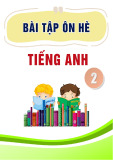
3
HNUE JOURNAL OF SCIENCE
Educational Sciences 2024, Volume 69, Issue 3, pp. 3-12
This paper is available online at https://hnuejs.edu.vn
DOI: 10.18173/2354-1075.2024-0041
ENGLISH TEACHERS’ LEARNING NEEDS FOR LANGUAGE TESTING AND
ASSESSMENT: AN EXPLORATORY STUDY
Dao Thi Bich Nguyen*1, Nguyen Thi Hoai1 and Nguyen Vinh Quang2
1Faculty of English, Hanoi National University of Education, Hanoi city, Vietnam
2Quality Assurance Center, Hanoi National University of Education, Hanoi city, Vietnam
Corresponding author Dao Thi Bich Nguyen, e-mail: nguyendb@hnue.edu.vn
Received May 14, 2024. Revised June 18, 2024. Accepted July 12, 2024.
Abstract. Language assessment has been a critical aspect in the field of English language
education, and one’s skills and knowledge of language assessment can be regarded as
assessment literacy. This exploratory study employed surveys to measure and understand the
learning needs for language testing and assessment of a diverse sample of English teachers
from various educational contexts in northern Vietnam, as well as the relationship between
their learning needs and personal factors including age, years of experience, and educational
level. The results showed that English teachers wanted greater training on designing language
tests, particularly those tailored to particular educational environments, and there is a
correlation between their training needs and their educational background, experience
teaching, and present teaching levels, and self-perceived language assessment literacy. The
findings of this research contribute to the ongoing discourse on teacher assessment literacy,
and it provides suggestions on the design of new materials for language testing and
assessment education programs.
Keywords: language testing and assessment, assessment literacy, learning needs.
1. Introduction
Language assessment literacy (LAL) is a major component of language teachers’
professional competence (Popham, 2009 [1]; Kremmel and Harding, 2020 [2]). In Vietnam,
developing teachers’ LAL has been the focus of the Ministry of Education and Training (MOET)
and the priority of the National Foreign Languages Project (NFLP) (Duong, 2019) [3].
Specifically, the NFLP has set the goal of enhancing English teachers’ assessment capabilities as
one of the important tasks for the period 2020-2025 [4]. In 2012, the English Teacher Competency
Framework (ETCF) for in-service EFL teacher education programs were proposed and developed
by MOET, and attached to the NFLP [5]. The framework consists of five domains, and teachers’
knowledge and skills in assessing students’ progress and proficiency or LAL is one major
descriptor of the domain of knowledge of language teaching. Moreover, developing teachers’
competence in testing and assessment is one of the training modules organized by the NFLP every
year. However, the content of the modules mostly focuses on designing test items for standardized
tests while inadequate attention has been paid to EFL teachers' alternative assessment practices and
literacy in Vietnam where traditional assessment has been upheld (Ngo, 2020 [6]; Tran, 2015 [7]).

Dao TBN*, Nguyen TH & Nguyen VQ
4
While teachers who are literate in language assessment are able to create and carry out
efficient testing procedures, effectively interpret test results and create appropriate lesson plans
for students and make logical decisions about their students' learning, insufficient LAL on the side
of educators could lead to poor language assessments, incorrect test score interpretations, and
illogical instructional guidance, all of which could be harmful to students (Weng & Shen, 2022) [8].
Despite its critical role in language instruction and evaluation, teachers' LAL continued to
be insufficient (Berry et al., 2017 [9]; Xu & Brown, 2017 [10]). Inadequate language evaluation
materials and inadequate assessment literacy training for teachers are included in TESOL
programs for aspiring teachers (Jeong, 2013 [11]; Popham, 2006 [12]), and in-service teachers
receive little opportunity for language assessment training (Crusan et al., 2016) [13]. Furthermore,
it was the fault of education officials and administrators at universities or schools to fail to
guarantee that instructors receive adequate training before beginning their teaching careers
(Coombe et al., 2012) [14]. Together, these elements impede the LAL development of teachers.
In Vietnam, there has been an increase in studies on testing and assessment. However, the
majority of research has focused on standardized tests (Chi, 2022) [15]; or difficulties faced by
language assessors when administering standardized tests (Chi, 2022) [15]. Other research has
concentrated on enhancing teacher-trainees assessment competency before they entered into the
teaching profession or enhancing the competency of in-service school teachers (Chi, 2022) [15].
This article describes the findings of a study designed to collect empirical data from language
teachers to discover what learning needs they have in language testing and assessment. The
intention was to use the outcome of the needs analysis to give empirically derived content to the
concept of assessment literacy and inform the design and construction of new materials that can
be used in language testing education programs. The study uses surveys to measure and understand
the assessment literacy levels of a diverse sample of English teachers from various educational
settings in northern Vietnam. Specifically, the study seeks answers to the following questions:
(1) What are English teachers’ training needs for language testing and assessment?
(2) What is the relationship between English teachers’ training needs for language and
testing and assessment and their teaching experience, teaching levels, educational levels, and
perceived LAL levels?
2. Content
2.1. Theoretical framework
2.1.1. Language Assessment Literacy
The term “language assessment literacy” (Stiggins, 1991 [16], 1997 [17]) has been accepted
to refer to the range of skills and knowledge that stakeholders require to deal with the new world
of assessment. However, there is little agreement on what assessment literacy comprises, despite
the increasing diversity of approaches recommended to encourage its development (Fulcher,
2012) [18]. While Stiggins (2002) [19] and McMillan (2000) [20] define teachers’ LAL as an
understanding of the principles of sound assessment to appropriately integrate assessment with
instruction and to utilize appropriate forms of teaching, Mertler views it as recognizing good
assessment practices, understanding assessment methods, reporting assessment results, and
integrating assessment and learning (2004) [21]. Similarly, Davies (2008) [22] and Taylor (2009)
[23] posit that teachers’ LAL includes knowledge, skills, and principles of conducting
assessments appropriately. LAL is also used to refer to familiarity with testing practices, the use
of assessment methods, the explanation and analysis of collected results, the decision-making, and
use of assessment results for teaching (Boyle, 2005) [24]. Pill & Harding compare LAL with a bank
of competencies that permit its owners, or teachers, to judge, create, and analyze tests (2013) [25].

English teachers’ learning needs for language testing and assessment: An exploratory study
5
The present study adopts Fulcher's (2012) [18] perspective on teachers' LAL, which posits
that the components of teachers’ LAL include knowledge, skills, and abilities necessary for the
creation, development, upkeep, and evaluation of large-scale standardized and/or classroom-
based assessments. Teachers’ LAL also entails being conversant with test procedures and
conscious of the ideas and precepts that support and direct practice, such as codes of ethics.
Additionally, in order to assess the function and effects of testing on institutions, society, and
individuals, as well as to understand why certain practices have developed the way they have,
assessment literacy necessitates the ability to situate knowledge, skills, processes, principles, and
concepts within larger historical, social, political, and philosophical frameworks.
2.1.2. Assessment Literacy Survey Instrument
Fulcher (2012) [18] developed and piloted a survey instrument to investigate the assessment
literacy of language teachers. The survey was delivered over the Internet using Lime Survey
Software and was widely advertised through professional organizations and discussion lists. The
intended population was described as “language teachers,” but the sample was essentially self-
selecting. The survey comprised both closed- and constructed-response items and used a number
of innovative design features that encouraged teachers to express needs independently of the
suggested response options. The survey was piloted with a group of language teachers before
being launched more widely. The survey results were analyzed using both quantitative and
qualitative methods, and the outcomes were used to inform the design of new teaching materials
and the further development of online resources that could be used to support program delivery.
2.2. Methodology
2.2.1. Research design
This study was an exploratory study which is an investigation into a study topic to find
something novel and fascinating (Elman et al., 2020) [26]. Using this research design, it was
expected to figure out English language teachers’ training needs for language testing and
assessment, thus providing interesting data for the material design of testing and assessment
programs in Vietnam.
2.2.2. Participants of the study
Convenience sampling was employed in this study. 368 English teachers from three
provinces in northern Vietnam, consisting of 48.4% secondary school teachers and 51.6% high
school teachers, participated in the study. The proportion of female teachers was approximately
80%, four times as high as that of male teachers. There was also a diversity in the age range, years
of experience, and education level among the participants, as shown in Table 1 below.
Table 1. The participants’ age range, years of experience, and educational levels
Age range
(years
old)
Number of
participants
Years of
experience
Number of
participants
Highest
educational level
Number of
participants
21-25
4 (1.1%)
Less than 5 years
16 (4.3%)
High school
graduate
2 (0.5%)
26-30
14 (3.8%)
5-10 years
19 (5.2%)
Bachelor degree
291 (79.1%)
31-35
19 (5.2%)
10-20 years
184 (50%)
Master degree
66 (17.9%)
36-40
63 (17.1%)
More than 20 years
149 (40.5%)
Doctorate degree
0 (0%)
41-45
175 (47.6%)
Others
9 (2.4%)
46-50
79 (21.5%)
51-55
14 (3.8%)

Dao TBN*, Nguyen TH & Nguyen VQ
6
2.2.2. Data collection and analysis
A survey instrument adapted from Fulcher (2012) [18] was employed to collect data for the
study. There were two main parts to the questionnaire. In the first part, the participants answered
5 personal questions regarding their gender, age range, current educational level, working
institution, and years of experience. The second part of the questionnaire consisted of 8 items,
both multiple-choice and open ones, about their understanding and needs for language testing and
assessment. The survey was delivered to the participants via Google Forms, and it took them
about 15 minutes to complete the questionnaire.
After being collected, data were then analyzed with cross-tabulation by Statistical Product
and Services Solutions (SPSS). This helped the researchers to investigate the relationship between
the variables in the survey’s items. Moreover, data from open items were analyzed using content
analysis to figure out different themes in the participants’ responses.
2.3. Research findings and discussion
The main purpose of this study is to support the development of language testing and
assessment training programs for English teachers in secondary and high schools in Vietnam. It
can also provide valuable insights for researchers and educational experts on how to improve
LAL among foreign language teachers in secondary education. Additionally, it promotes attention
to the important issue of providing effective language testing training and integrating it into
foreign language teacher training programs. Therefore, with the collected data, we will analyze
the content of the open-ended questions regarding the courses and books on testing and
assessment they have undergone, as well as their needs for content-related training in language
testing and assessment. For the closed-ended questions, exploratory analysis will be conducted to
examine respondents' perspectives on 23 items in question 8 regarding the knowledge and skills
needed in language assessment, as identified in Fulcher's (2012) [18] study, as well as their
relationships with other items such as teaching experience, educational level, current teaching
level, and self-perceived language testing and assessment competence of the participants.
2.3.1. The open questions
Questions 6 and 7 were designed to encourage teachers to compare their training experiences
in language testing and assessment with their awareness of what they still need to be trained in
order to use assessment effectively in their current teaching. When asked about the training
contents (question 6), the majority of the participants said they had received training on
constructing test specifications and designing test items. However, for question 7 which asked
about their further training needs to effectively carry out language assessment tasks,
approximately 40% of the participants expressed a desire for training in methods of designing
tests that ensure value and reliability, scoring speaking and writing skills, and analyzing and using
test data in teaching.
Question 9 asked about the books/ materials on language testing and assessment teachers
have recently read and what they liked or disliked about the materials. The majority of the answers
mainly mentioned reading materials of the training programs which provided them with theories
and practical examples of language assessment suitable for the current secondary education
curriculum and closely related to teachers' practical jobs. However, as commented by the
participants, the materials’ content was not deep enough, and the examples were not abundant. A
few teachers mentioned reading such books as “Testing for Language Teachers” and “Practical
Language Testing,” which have in-depth content, various examples, and explicit instructions, but
some aspects of the books did not align with the Vietnamese secondary education curriculum.
Questions 10, 11, and 12 addressed the topics in books/ materials on language testing and
assessment more specifically, which were their perceived crucial topics and their desired ones.
The opinions expressed generally emphasized the need for systematic content, covering concepts

English teachers’ learning needs for language testing and assessment: An exploratory study
7
such as assessment forms, assessment organizing techniques, matrix design techniques, test item
design, language skills testing, and test result analysis and use. They particularly desired specific
guidance and examples that are closely related to the current secondary education curriculum.
2.3.2. The close-ended questions
2.3.2.1. Teachers’ language assessment training needs
Question 8 consisted of 23 items representing the knowledge and skills necessary for teachers
to carry out language assessment practices. The survey data was subjected to exploratory factor
analysis (EFA) using SPSS software to identify the main factors in the additional training needs
for language testing and assessment among secondary and high school English language teachers
in Vietnam. The EFA results, using the Maximum Likelihood method and Varimax rotation, with
a cutoff point of 0.5 (considered practically significant according to Hair et al., 1998, p111) [27],
revealed the emergence of two factors with eigenvalues greater than 1, explaining 75.6% of the
observed variable variance as follows:
Table 2. Total variance explained
Table 3. Rotated factor matrix
Rotated Factor Matrixa
Factor
1
2
c8.4
.867
c8.3
.864
c8.5
.861
c8.9
.809
c8.14
.797
c8.18
.783
c8.2
.771










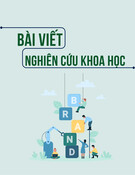
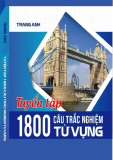
![Tài liệu Từ vựng tiếng Anh Trung cấp [mới nhất]](https://cdn.tailieu.vn/images/document/thumbnail/2025/20250913/nguyentuan250421@gmail.com/135x160/99491757910839.jpg)
![Tài liệu Từ vựng Tiếng Anh theo chủ đề [mới nhất]](https://cdn.tailieu.vn/images/document/thumbnail/2025/20250913/namdhuet@gmail.com/135x160/83251757753810.jpg)

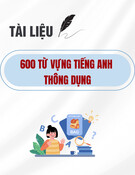
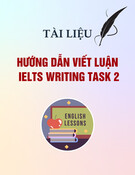
![Tài liệu Từ vựng tiếng Anh cho bé [chuẩn nhất/mới nhất]](https://cdn.tailieu.vn/images/document/thumbnail/2025/20250731/huadaithesang2509@gmail.com/135x160/18631754013896.jpg)





